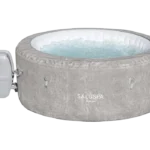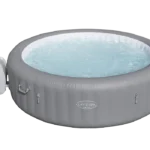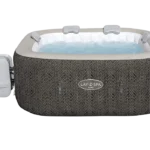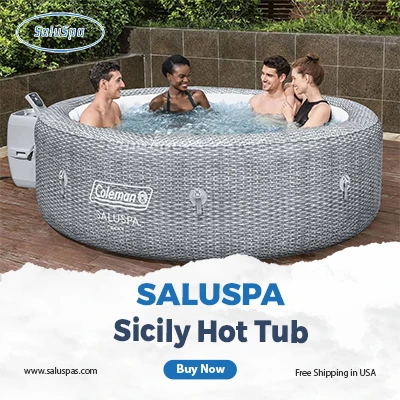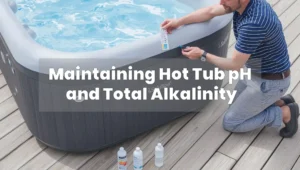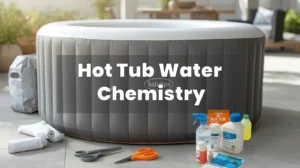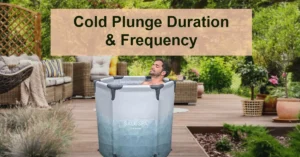Keeping water clean and safe is critical to having a SaluSpa that is inviting and hygienic for soaking. It’s easy to sanitize your water by using chlorine tablets. These give your water slow, steady sanitizing. But how many tablets are too many for a SaluSpa? Well, too many tablets will cause skin irritation. Too few will not be able to effectively sanitize the water, leaving it cloudy and unsafe.
With this handy guide, you’ll know just how many chlorine tablets in SaluSpa you need, how to use them the right way, and vital maintenance tips you have to keep to have ideal hot tub water chemistry.
What Are Chlorine Tablets, and Why Use Them in SaluSpa?
Chlorine tablets are an easy way to keep the water clear and stop bacteria, algae, or any other harmful growth. Unlike liquid chlorine, which works right away, these tablets break down slowly giving steady cleaning for many days.
Benefits of Using Chlorine Tablets in SaluSpa:
-
Convenience: Tablets can last for 3–5 days, reducing the need for daily chlorine addition.
-
Stable Sanitization: They dissolve slowly and maintain the ideal chlorine level.
-
Easy to Handle: Less messy compared to powders or liquids.
-
Effective: Works efficiently to kill bacteria and oxidize contaminants.
Many SaluSpa owners prefer tablets because they require minimal effort, especially when used with a floating chlorine dispenser.
How Many Chlorine Tablets in SaluSpa? (Dosage Guide)
The number of chlorine tablets for SaluSpa depends on your model’s water capacity. As a general rule:
-
Use 1 chlorine tablet per 250 gallons of water to maintain a chlorine level of 1–3 ppm (parts per million).
Since most SaluSpa models range from 177 to 290 gallons, you will usually need ½ to 1 tablet at a time.
Quick Dosage Table for Popular SaluSpa Models
Tip: Always start with a smaller amount (e.g., half a tablet for smaller models), test your chlorine level after a few hours, and adjust if needed.
Step-by-Step Guide: Adding Chlorine Tablets in SaluSpa
Proper use of chlorine tablets makes it possible to keep the water clean without ruining your hot tub’s liner or parts. Do not add chlorine tablets directly to the water since they may bleach or harm the liner.
How to Add Chlorine Tablets:
-
Test the water pH and alkalinity first.
-
Ideal pH: 7.4–7.6
-
Alkalinity: 100–150 ppm
-
-
Use a floating chlorine dispenser.
-
Place the tablet inside the floater and adjust the opening for slow release.
-
-
Set the floater’s dial.
-
Start at a medium setting and adjust based on test strip results.
-
-
Circulate the water.
-
Run the pump or jets for even chlorine distribution.
-
-
Test chlorine levels regularly.
-
Aim for 1–3 ppm of free chlorine.
-
How Often Should You Add Chlorine Tablets?
Tablets will dissolve over time and usually last anywhere between 3-5 days. This, of course, depends on the temperature of the water, bather load, and how open the floater is.
-
Check chlorine levels at least twice a week using test strips.
-
Add a new tablet when levels fall below 1 ppm.
-
Shock your hot tub weekly using chlorine shock or non-chlorine shock to break down combined chlorine and refresh water clarity.
Common Mistakes to Avoid When Using Chlorine Tablets
Using chlorine tablets seems easy, but mistakes can lead to water problems or skin irritation.
Avoid These Mistakes:
-
Over-chlorinating: Using too many tablets can cause chlorine levels to rise above 5 ppm, leading to strong odors, skin irritation, and liner damage.
-
Skipping tests: Not checking chlorine and pH levels regularly can result in unsafe water.
-
Not balancing pH: Even if chlorine levels are correct, improper pH (too high or low) will make chlorine less effective.
-
Placing tablets directly in the spa: Always use a floating dispenser.
Weekly Maintenance & Chlorine Shocking
Even with chlorine tablets, weekly hot tub shock treatments are essential to oxidize organic matter and refresh water.
-
Chlorine shock: Raises chlorine levels temporarily to kill bacteria.
-
Non-chlorine shock: Oxidizes contaminants without raising chlorine levels.
After shocking, wait until the chlorine level drops back to 1–3 ppm before using the spa.
Chlorine Granules vs. Tablets vs. Liquid Chlorine
While chlorine tablets are the most common choice for SaluSpa owners, it’s worth knowing the alternatives.
| Type | Pros | Cons |
|---|---|---|
| Tablets | Long-lasting, convenient, easy to dose | Slow to raise chlorine quickly |
| Granules | Fast acting, good for quick adjustments | Requires manual measuring |
| Liquid Chlorine | Immediate action, no residue | Short shelf life, higher handling risk |
For regular maintenance, tablets are the easiest solution, while granules or liquid chlorine are better for quick adjustments or shock treatments.
Chlorine vs. Bromine for SaluSpa: Which is Better?
Chlorine works quickly and is readily available whereas bromine is more stable at higher temperatures and kinder to the skin.
-
Chlorine: Best for those who prefer a quick sanitizer and don’t mind regular dosing.
-
Bromine: Lasts longer and maintains levels better in hot water but can be slightly more expensive.
Both are effective; the choice depends on your preferences and budget.
FAQs About Chlorine Tablets in SaluSpa
How many chlorine tablets should I start with?
For most SaluSpa models, start with ½ to 1 tablet and test after 3–4 hours.
Can I use chlorine tablets without a floater?
No, always use a floating dispenser to avoid damaging the liner.
How long does a chlorine tablet last in SaluSpa?
Typically 3–5 days, depending on water temperature and circulation.
How often should I shock my SaluSpa?
Shock your spa once a week or after heavy use.
Can I mix chlorine and bromine?
No, never mix them directly. It can create harmful chemical reactions.

